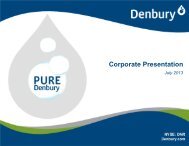Interactive 2009 Annual Report (PDF 7.56 MB) - Denbury Resources ...
Interactive 2009 Annual Report (PDF 7.56 MB) - Denbury Resources ...
Interactive 2009 Annual Report (PDF 7.56 MB) - Denbury Resources ...
- No tags were found...
You also want an ePaper? Increase the reach of your titles
YUMPU automatically turns print PDFs into web optimized ePapers that Google loves.
<strong>Denbury</strong> <strong>Resources</strong> Inc. <strong>2009</strong> <strong>Annual</strong> <strong>Report</strong> 63<strong>2009</strong>, commodity prices increased, resulting in an increase in our proved reserves of 4.2 M<strong>MB</strong>OE. These changes inquantities affect our DD&A rate, and the combined effect of changes in quantities and commodity prices impactsour full cost ceiling test calculation. For example, we estimate that a 5% increase in our estimate of proved reservesquantities would have lowered our fourth quarter <strong>2009</strong> DD&A rate from $14.77 per BOE to approximately $14.19 perBOE, and a 5% decrease in our proved reserve quantities would have increased our DD&A rate to approximately$15.42 per BOE. Also, reserve quantities and their ultimate values are the primary factors in determining the borrowingbase under our bank credit facility and are determined solely by our banks.Under full cost accounting rules, we are required each quarter to perform a ceiling test calculation. We did not havea full cost pool ceiling test write-down in 2007 or <strong>2009</strong>. However, during 2008, commodity prices were volatile, withoil NYMEX prices moving from $95.98 per Bbl at December 31, 2007, to $140.00 per Bbl at June 30, 2008, then downto $44.60 per Bbl at December 31, 2008. Likewise, natural gas NYMEX prices went from $7.48 per Mcf as ofDecember 31, 2007, to $13.35 per Mcf at June 30, 2008, and down to $5.62 per Mcf as of December 31, 2008. Becauseof the 54% decrease in NYMEX oil price and 25% decrease in NYMEX natural gas price between year-end 2007 andyear-end 2008, we recognized a full cost pool ceiling test write-down during 2008 of $226.0 million, or $13.32 per BOE.Commodity prices increased throughout <strong>2009</strong>, ending the year with NYMEX oil prices at $79.36 per barrel, and NYMEXnatural gas prices at $5.57 per Mcf. Commodity prices have historically been volatile and are expected to be in thefuture. If oil and natural gas should again decrease, we may be required to record additional write-downs due to the fullcost ceiling test. Beginning in the fourth quarter of <strong>2009</strong>, the full cost accounting rules require the use of the averagefirst-day-of-the-month oil and natural gas price for each month during the 12-month period ended as of eachquarterly reporting period. The amount of any future write-down is difficult to predict and will depend upon the oil andnatural gas prices utilized in the ceiling test, the incremental proved reserves that might be added during each periodand additional capital spent.Tertiary Injection CostsOur tertiary operations are conducted in reservoirs that have already produced significant amounts of oil over manyyears; however, in accordance with the rules for recording proved reserves, we cannot recognize proved reservesassociated with enhanced recovery techniques such as CO 2 injection, until there is a production response to theinjected CO 2 , or unless the field is analogous to an existing flood. Our costs associated with the CO 2 we produce (oracquire) and inject are principally our costs of production, transportation and acquisition, and to pay royalties.Prior to January 1, 2008, we expensed currently all costs associated with injecting CO 2 that we used in our tertiaryrecovery operations, even though some of these costs were incurred prior to any tertiary related oil production.Commencing January 1, 2008, we began capitalizing, as a development cost, injection costs in fields that are in theirdevelopment stage, which means we have not yet seen incremental oil production due to the CO 2 injections (i.e., aproduction response). These capitalized development costs will be included in our unevaluated property costs if thereare not already proved tertiary reserves in that field. After we see a production response to the CO 2 injections (i.e., theproduction stage), injection costs will be expensed as incurred and any previously deferred unevaluated developmentcosts will become subject to depletion upon recognition of proved tertiary reserves. Had the new method of accountingfor tertiary injection costs been used in periods prior to January 1, 2008, the effect on our financial statements wouldhave been immaterial for all periods presented. During 2008 and <strong>2009</strong>, we capitalized $10.4 million and $8.0 million,respectively, of tertiary injection costs associated with our tertiary projects that we would have previously expensed.Income TaxesWe make certain estimates and judgments in determining our income tax expense for financial reporting purposes.These estimates and judgments occur in the calculation of certain tax assets and liabilities that arise from differencesin the timing and recognition of revenue and expense for tax and financial reporting purposes. Our federal and stateincome tax returns are generally not prepared or filed before the consolidated financial statements are prepared;therefore, we estimate the tax basis of our assets and liabilities at the end of each period as well as the effects of taxrate changes, tax credits, and net operating loss carryforwards. Adjustments related to these estimates are recorded inour tax provision in the period in which we file our income tax returns. Further, we must assess the likelihood that wewill be able to recover or utilize our deferred tax assets (primarily our enhanced oil recovery credits and state lossManagement’s Discussion and Analysis of Financial Condition and Results of OperationsForm 10-K Part II




